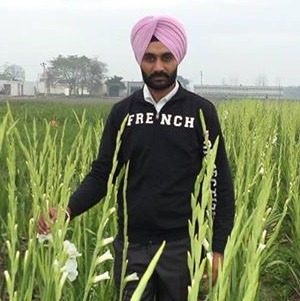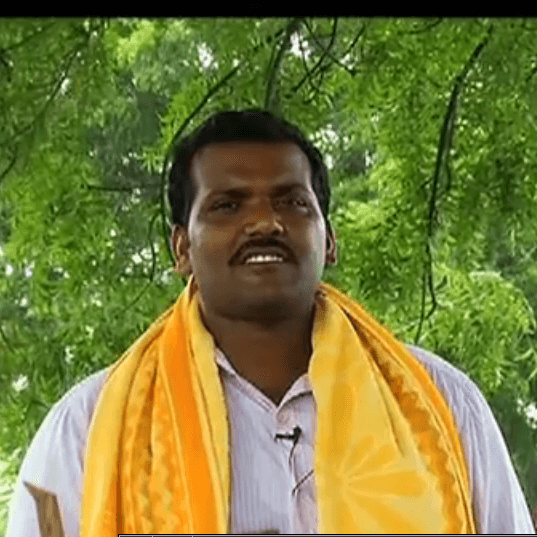Young Agripreneur Booming In Floriculture Business by Blossoming Holland Gladiolus in Punjab
It is said that success is not that easy to attain, you have to taste failures many times, only then you can enjoy the real flavor of success. Same was the case with Gurwinder Singh Sohi- a normal student who opted farming when he wasn’t able to crack the Punjab JET Exam.
He was determined from the beginning that he was not going to act like a sheep and start his family occupation of wheat-paddy cultivation. So, he started mushroom farming, but it was not that successful, soon after that he setup his own sweet shop in the nearby town- Khamano. But maybe he was not meant for that also, so he took up the profession of horse breeding and later on he shifted his profession to jeep customizing.
After leaving all these jobs, in 2008, he came to know about a news that, Punjab Horticulture Department is giving subsidy on Holland Gladiolas Seeds and then the real game started for Gurwinder Singh Sohi. He started growing Gladiolas in 2 Kanals and gradually started adding more acres under the same flower. He started getting a higher price than the local variety of flower and his revenue also got increased.
The area got increased from eight acres to 18, of which 9 were his own and nine were on lease. He used 12 acres out of the total for gladiolus, 3 acre for marigold and the rest for pulses, paddy (mainly basmati), wheat, maize, and cattle fodder. The sowing (September-October) to harvesting (January- March) time of gladiolus is 7-8 months, while paddy and wheat have just opposite sowing and harvesting pattern, so the same land gives him revenue round the year. Moreover, these gladiolus are sold as Rs 7 per stick in wedding season and Rs 3 on an average. In this way, he has secured his income around the year.
Gladiolus crop is just like reaping treasure because the seeds of Holland variety are a one-time investment of 1.6 lakh per acre- which is later sold at Rs 2 per bulb and from that crop next year plants can also be prepared. Although it’s a one-time investment, it requires large workforce while sowing and seed extraction from Feb-April and labour almost cost is up to Rs 40,000 an acre.
The marigold field is also rewarding and it generates profit around Rs. 1.25 lakh to Rs 1.3 lakh every season. And this revenue is far better than wheat and paddy. All-n-all after taking out the land lease, labour and another input cost, he is left with the half of the total profit, and that is good enough.
His startup is with the name of RTS Flowers and it is booming in many cities of Punjab like Chandigarh, Ludhiana, and Patiala. However, he didn’t pursued his higher studies but time-to-time he up-skills himself to become a pro in marketing and today he is selling his gladiolus produce across the country through his firm’s Facebook Page and other online websites like India-mart.
With the coming modern marketing skills and advancement, Gurwinder has also updated himself about the term agri-marketing, and his work is in progress on the concept of farm-to-fork. He and his 12 friends have installed drip irrigation, solar pumps and other agriculture equipment with the help of government departments, and has also setup a Friends Farmers Welfare Club which has a membership of Rs. 5000 each so that in future they can buy other machinery like rotavator, power spray, and seed drill. And to promote organic farming the members of the group has also started growing turmeric, pulses, maize and basmati organically. And to expand their market of the organic food industry, they have started marketing the produce directly to the customers through Whats App groups. And to ensure that the customer and farmer both get the fair deal, they directly market their produce to 30 homes in Mohali and soon they will be staring their service through website also.
Recently, they have also started a company named as Akal Farmers Producer Company Limited and all the crops produced by farmers are packed and sold under this company. They have total 20 types of products like moong bean, black gram, chickpea, honey, Kidney beans, mustard oil, turmeric, 4 types of flour, Squashes, Garam Masala, Lassi Masala etc. and to expand the business they have also opened a shop in their village for selling the products and farmers income has increased by this. Besides this Gurwinder Singh Sohi also organizes farming, Horticulture and KVK camps on his farm to motivate other farmers.
Gurwinder Singh Sohi’s young mind hasn’t stopped dreaming and soon he will be coming up with more bright ideas to chase.
MESSAGE TO FARMERS
“Farmers should work in unity by making small groups, because buying and using farming machinery in this way is easy. By using machines in a group the expenditure get reduced resulting into a profitable venture. I’m also doing the same, I have also made a group in which we buy machines by the group names and all the members of the group can use it.”









